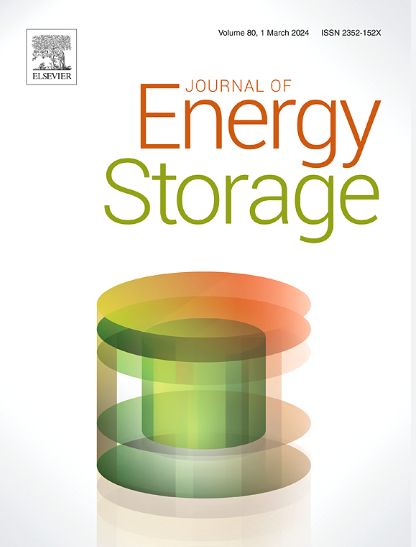孔隙率梯度分布对泡沫铜/石蜡复合相变材料传热特性的影响
IF 8.9
2区 工程技术
Q1 ENERGY & FUELS
引用次数: 0
摘要
本文采用有限元分析方法对泡沫铜/石蜡复合材料PCM在熔融过程中的热物理特性进行了数值研究。基于不同孔隙度的单元四面体模型,设计了6种不同孔隙度梯度分布的泡沫铜/石蜡复合材料PCM,并对不同孔隙度梯度分布的泡沫铜/石蜡复合材料PCM模型进行了三维直接数值模拟。验证了解析模型和数值方法的准确性,并观察到高度的一致性。研究了不同孔隙度梯度分布的相变材料在熔融过程中的相场分布和温度变化及其对储热性能的影响。结果表明,改变孔隙率分布可以显著提高相变材料的传热性能和储热能力。l型分布(左侧为82.06%)可以最大限度地提高复合PCM的换热率,同时保持较好的储热能力。与均匀孔隙率89.03%的相变材料相比,相变时间缩短了16 s,储热率提高了5.7%。本研究结果为孔结构增强复合材料PCM的传热特性研究提供了新的思路。本文章由计算机程序翻译,如有差异,请以英文原文为准。
The role of porosity gradient distribution on the heat transfer characteristics of copper foam/paraffin composite phase change material
In this paper, the thermophysical properties of copper foam/paraffin composite PCM during the melting process were numerically investigated by using the finite element analysis (FEA) method. Based on the unit tetrakaidecahedron model with different porosity, six copper foam/paraffin composite PCM with different gradient porosity distributions were designed, and three-dimensional direct numerical simulations were carried out for the copper foam/paraffin composite PCM models with different gradient distributions. The veracity of the analytical model and the numerical method had been validated, and a high degree of concordance had been observed. The phase field distributions and temperature changes of the PCMs with different porosity gradient distributions during the melting process and their effects on the heat storage performance were investigated. The results show that the heat transfer performance and heat storage capacity of the PCMs can be significantly improved by changing the porosity distribution. The L-shaped distribution (82.06 % on the left) could maximize the heat transfer rate of the composite PCM while maintaining a better heat storage capacity. The phase change time was reduced by 16 s and the heat storage rate was increased by 5.7 % compared with the 89.03 % uniform porosity PCM. The results of this study provide new insights into the study of heat transfer properties of pore structure-enhanced composite PCM.
求助全文
通过发布文献求助,成功后即可免费获取论文全文。
去求助
来源期刊

Journal of energy storage
Energy-Renewable Energy, Sustainability and the Environment
CiteScore
11.80
自引率
24.50%
发文量
2262
审稿时长
69 days
期刊介绍:
Journal of energy storage focusses on all aspects of energy storage, in particular systems integration, electric grid integration, modelling and analysis, novel energy storage technologies, sizing and management strategies, business models for operation of storage systems and energy storage developments worldwide.
 求助内容:
求助内容: 应助结果提醒方式:
应助结果提醒方式:


